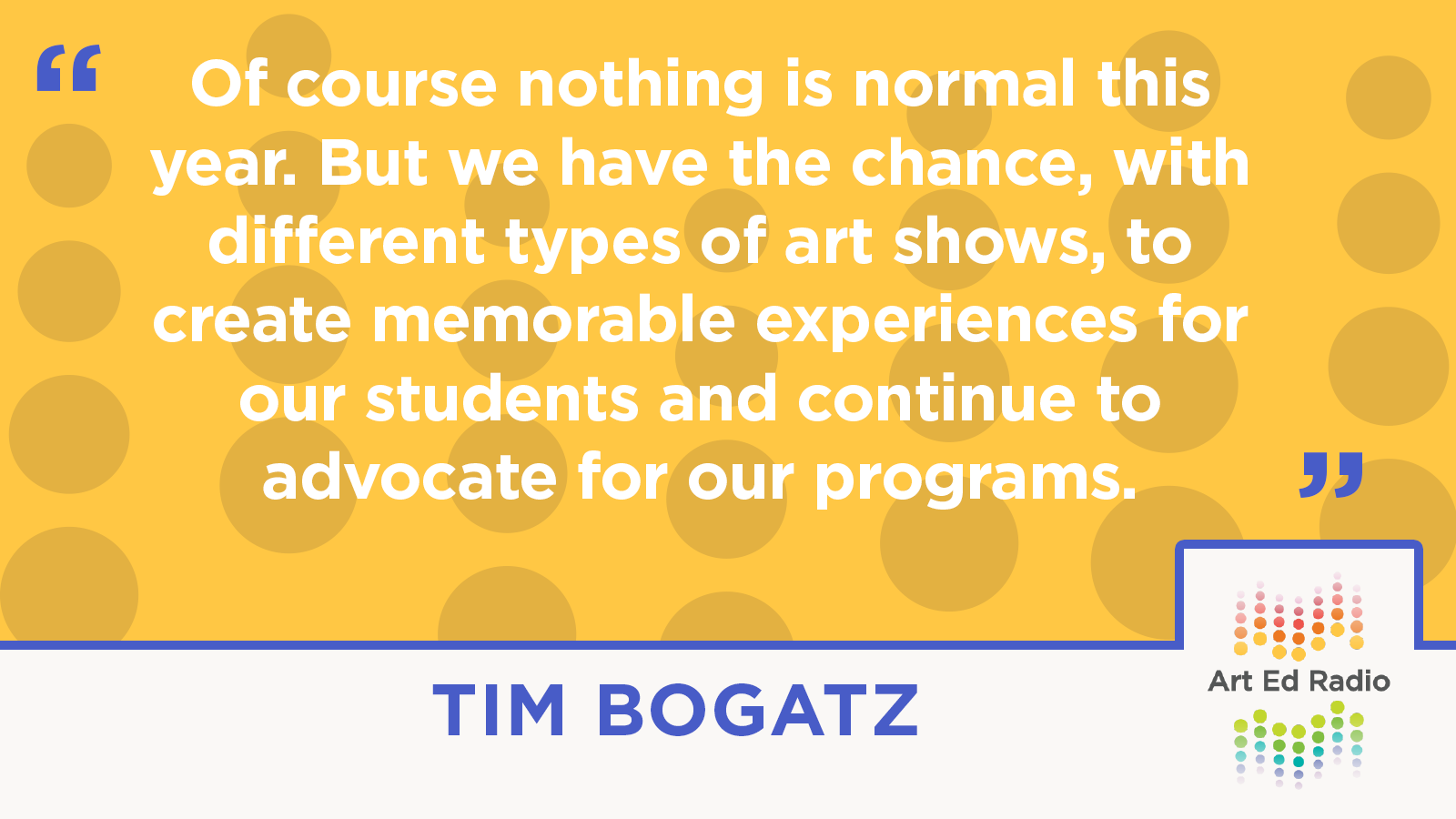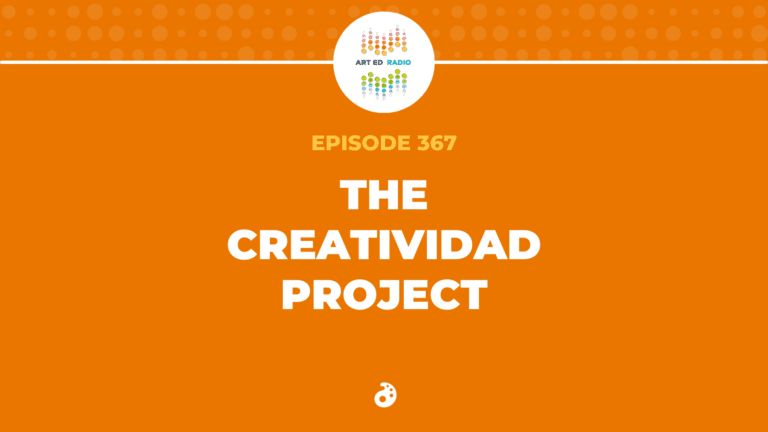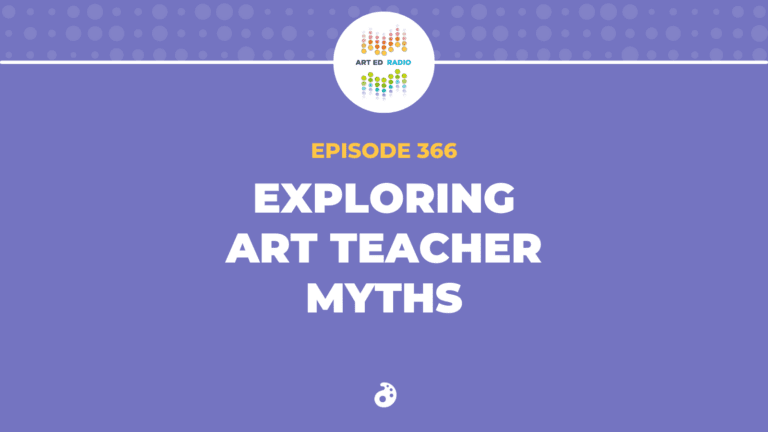As the first quarter comes to a close, Tim is spending some time reflecting on what the rest of the school year is going to look like for everyone. And one of those future concerns is what art shows might look like this year. In this episode, Tim discusses some ideas for alternative art shows, including how we can incorporate technology, move shows outside, and simplify things to make the process easier for everyone. Full Episode Transcript Below.
Resources and Links
- Harnessing the Power of Art in Uncertain Times
- Organizational Tips for Your Art Shows
- A Month of Art Advocacy Ideas
- Keeping Visitors Engaged at Your Art Show

Transcript
Tim: Welcome to Art Ed Radio, the podcast for art teachers. This show is produced by the Art of Education University and I’m your host, Tim Bogatz
We are continuing our way through the school year, which honestly, it seems like it’s going to be the longest year that any of us have ever experienced. Some days are really good, a lot of good things happening, a lot of exciting things happening. Some days are not so good. And we don’t don’t need to dive into those quite as much. But honestly, more than anything, I think everyone’s just kind of feeling tired right now, but I’m hoping at least that most of us are coming to an end with the first quarter. If you’re not already there, it’ll be coming soon. Don’t worry. You’ll get through it. And let me tell you, parent teacher conferences via email and parent teacher conferences via Zoom is a whole different world. And I don’t know if it’s better or worse, kind of going back to each day. Like some are really good. Some are not so good, but it’s definitely different.
And I’m curious to see if virtual conferences are something that sticks around because from my perspective, it just seems a lot easier for everyone. Like it makes it a lot easier for parents and grandparents and whoever else that needs to come, makes it easier for them to show up. It makes it easier for families to be involved and that’s never a bad thing. So after we get back to normal, I’ll be curious to see whether we go back to how we did conferences before, or maybe it’s part of an evening, virtual part, in person and families can do what works for them. Anyway, not important. In any case, the end of the first quarter, and kind of thinking through, we’re doing some things differently, got me thinking about how we’re going to get through the rest of the year and the different things that might be coming in the future.
There are a lot of things that are going to look different, a lot of things that are going to be different. But one thing that kind of captured my attention as I was thinking through this was art shows. Are we doing art shows this year? What are art shows going to look like this year? And some people may be holding out hope that we’ll be back to normal by April or May, and that they can put on the usual end of the year art show. I unfortunately am not that optimistic. So I think we need to start thinking about some alternatives and these ideas don’t necessarily take the place of what you would normally do. Maybe some of the ideas are a little smaller, a little easier, but they do the job of getting your students work up in the building, getting your students some attention for what they’re doing, getting your art room some attention and a chance to let you do some advocacy on behalf of your students and on behalf of your program.
So that’s what we’re going to chat about today. And I would love to just share with you some ideas about some alternatives for art shows as we move through this strange, strange year. So first ideas all kind of have to do with technology and just different ways that we can incorporate technology when we’re doing our art shows. And I think there are a lot of good approaches. Maybe the simplest from a teacher perspective is to do something with Google Slides because if your students are old enough, if they know enough tech, if they’re working on their devices enough, they can do that easily. Like they know how to create a slide, they know how to share them, and you can let them do that collaboratively with Google Slides. You start something and let kids submit their work. That can save you a lot of time and you can have kids submit their artwork. They can do an artist’s statement. They could even do some process photos showing how this work was developed, how it got from sketch to the middle of the drawing to a little more detail to the finished product.
They can write artist statements or at least answer questions and talk a little bit more about their work. There are so many options and you can give those to them too, and just say, hey, here’s what you can do. Share this or this or this. Answer this question or this one or this one. And you can design it around a theme, you can leave it open-ended, but whatever you do, it’s a good chance to share a lot of different types of work. And like I said, if you have the kids design that themselves, they put that together virtually you can just give it a quick, once over, arrange it as needed. And then share that out wider with your staff, with your admin, with families, and then people can view it whenever they have time. It’s another beautiful thing about technology and being able to access things remotely, people can do it at their leisure. They can view the art show whenever it’s convenient for them and I think that is a really good thing.
Another idea that I was thinking about, just bringing about a little bit more technology is to do a virtual tour of the art show. And so in this way, you could set up the art show as you normally do, as you always do. Maybe it’s a little smaller, maybe it’s in a different location, depending on what you can do with your setup and your building. But you can walk through, you can give people a tour, maybe it’s narrated, maybe it’s not, but just a quick video gives people a chance to see the show, even though they are remote, even though they are not there. And it’s almost like the real thing.
And on top of that, it gives your kids the chance to maybe have a show that’s a little more normal, at least with the school aspect of it. Even if families can’t be there or if kids can’t be there, you can still see, like there’s an art show set up, whether you’re doing that however, if your kids are in person or [inaudible 00:07:31] you have their actual artwork, you can hang it up, you can do a virtual tour. And I think that can be a wonderful thing.
And then just one other idea I was thinking tech-wise is you have the ability to share on social media, whether you’re on Instagram or Twitter or Facebook or whatever you have, there’s so many options of what you can do to share what’s going on in your art room. Maybe that’s something that you don’t do on a regular basis because we all know that time and energy are tough to come by this year. But when it’s art show time, maybe you highlight a few artists of the week, in the weeks leading up to when your art show would be, and you can show multiple pieces of their work. You can give them a kind of a spotlight and show everything that they’re doing.
Or you could highlight a specific grade like, hey, fourth grade is doing these awesome projects. Or hey drawing two or painting one or intro to art, just narrow it down and just show what an entire class is doing. And you can feature work in that way from a lot of different students and share a lot of different things. So again, not quite as good as an art show, but still allowing people to see what’s being developed, what’s being created in the art room which is a very, very important piece of the puzzle.
Next category of shows that I was thinking about again, because we’re pressed for time, we’re pressed for space, we’re pressed for energy, maybe bring it down a little bit and put on kind of a miniature show. And there are a few different ways that you can do this. The first one, I think is just have some miniature paintings and drawings. They can be small size, whatever size kids want to do and whatever topic subject you want to do. If you want to give them some choice as to what they create or what they submit, you can definitely do that. If you want to give your kids a theme and have them interpret a specific theme, then you can do that. If you want to lay out some more stringent requirements for what needs to be done, that’s cool too, whatever works for you, whatever works for your students.
But if you have dozens of these miniature paintings or drawings, or small sculptures, whatever you may have that makes for a really interesting visual, it can be a perfect small show that’s perfect for the entryway in your school, or maybe a display case. Just anytime you’re limited by space or have a small area put up some smaller artworks in there. And that can be a great avenue for you to display some of your students’ work. And I remember, I used to have this display case in a different part of the school. And so it was kind of annoying to honestly like trek artwork all the way across the building and hang it up there. But it also gave us the ability to show off more work and highlight some kids that maybe would not get their work seen otherwise.
And there would be times where, like I said, going back to those ideas, you could highlight an individual student and let them put up like eight of their works. Or you can highlight an entire class, or you can highlight a theme or a specific project that you’re doing and put that altogether. And if you have something small, it’s easy for you to hang that. It’s easier for kids to hang that if you are seeing them in person a little bit, and all of those things can be put together to create a really fun, kind of miniature show.
And a couple other ideas sort of related to them. You can do just a note card gallery where you give kids a three by five note card and maybe have them all do a portrait. Or have them all work in ballpoint pen, or have them fill the entire note card with an abstract design that focuses on color, whatever you want to do, any type of theme and just hang them together and seeing all of those artworks that are the same size, but with different interpretations or different ideas can be really visually interesting. And so that can create a really good lesson for you. And again, figure out what works for you, what works for your students and have them design an artwork on that note card.
And then when you put that all together, whether it’s in person or whether you just are doing that virtually, putting pictures in slides or however, you’re arranging this, there’s a lot that you can do to put all that together and just having the symmetry of everybody working on a note card. Or putting all of those together again, same size, the repetition of that can be really, really interesting visually. And just a different way to kind of approach that or do that.
And then the last idea that I was thinking with something that’s small, something in miniature, is do a collaborative mural out of note cards or sticky notes are really fun, or however you want to approach that. There’s a lot of possibilities. Ian Sands, a long time ago put together these really cool collaborative murals out of sticky notes, where he just got different colors of sticky notes and had kids put things together to create a bigger visual image. And I think everybody’s done that before where each kid gets a small square that forms a larger part of the whole. They don’t know what it’s going to look like when you put it together, but they just work on their own small square. You put them all together when it’s done and you have a big collaborative piece, which can be really fun. And there’s a lot of different ways to do that.
Or again, just like you did with the note cards, you can do that on the sticky notes too. Draw your favorite character on there, create a brand new character, or do a simple line drawing or Zentangles, and just hanging them all together, displaying them, showing them altogether can be really cool. So there’s a lot you can do with miniature shows that I think can be kind of interesting.
Now, a quick break before we dive into the last few ideas, because I want to talk to you a little bit about Art Ed PRO. We’ve just flipped to the month of November. And of course with the new month comes three new pro packs. And this month we have three that I think are especially applicable right now. There’s teaching art from a cart. There is digital drawing. And there is helping students create a body of work. All of them are great packs, they’re all worthwhile, especially with the teaching situation being what it is right now.
In particular, I think Lindsay Moss’s new pack about teaching art on a cart is amazing. Lindsay always does great things and this pack is no exception. She has so many resources, so many ideas, so many lesson plans for teaching art on a cart that really make teaching art from a cart worthwhile. And I think maybe most importantly, she can change your mindset about teaching from my cart and show you how you can do amazing things. Like I watched our pro pack and as soon as it was done, I was like, yep, let’s do this. I can teach art for cart. And it was really inspiring and it really made me realize what good things we can do teaching art from a cart. So check that out.
Abby Schukei did a digital drawing pack, which is spectacular. Just everything you need to know to get your kids started with digital drawing. And then Lena Rodriguez did a pro pack on helping students create a body of work. It’s perfect for anytime you’re working with advanced kids, working on extended lessons, putting together portfolios, even those in stained investigation, if your kids are doing AP studio art. So make sure you check those out. If you are not a pro member, you might be able to get your school to pay for your subscription. So take a look and get the information that you need at theartofeducation.edu/pro. Now back to smart show ideas.
The last sort of category that I want to talk about is doing art shows that are outdoors. And this is maybe not the best idea as we move into November and December, but I think it’s worth looking at when spring rolls around. And I did an entire episode back in August or September, I think all about doing work outside with just so many ideas, so many lessons for getting your kids outdoors. And I think there’s a good opportunity there for you when the weather allows or when the weather permits for you to turn that into an entire evening. It’s a little bit safer way if you can maybe get people around the school, not necessarily in the school, but it’s your chance to do something still socially distant, but kind of in person.
Can you set up a temporary art show? Do something outdoors, set up easels or display work in a courtyard or even a parking lot, think like trunk or treat where kids come around to the trunk of your car and pick up candy for Halloween. What if that were an art show? What if you have families bring their students and they can display some of their work in the back of their car? You can walk around the parking lot and have a really cool, really unique socially distant art show. I think that’s a really cool idea. And I think people are looking for things like that to do. And I think it could be a really fun way to kind of display some work and get everybody gathered in one place.
The other outdoor thing that I think is really cool, a really good idea is you can create art on the sidewalk. If you want families to participate, you can do that socially distant too. Give each family a handful of sidewalk, chalk, spread them out on sections to let them create different drawings on their sidewalk. And again, you can let them do whatever they want. You can give them a theme, you can give them an assignment, but that could be a really cool outdoor participatory evening, where you have families getting together, you’re creating art, you’re seeing art that other people are creating, which is something fun, it’s something enjoyable and something unique that I think people love to do. And if you don’t have sidewalk chalk or you can’t afford too much of it, then I understand. Like budgets are tight.
One thing that I’ve done before is I just got white chalk. People, a lot of times, just to have chalkboard sitting around, you can get it donated from places. And then I just ended up paying out of my pocket for a big bag of charcoal, like the briquettes work, like Kingsford charcoal type thing, but you can also get other types of charcoal that you would use for grilling. And they actually work great for drawing on the sidewalk, which seems weird, but they create these like rich dark values, which is super interesting. And you can mix that with like the white chalk.
You can create these amazing grayscale drawings. And so it’s not free, but it’s not super expensive. And if you have a giant bag of charcoal and you just hand that out, the families can look at you weird, your students can look at you weird, but you’re like, no, go draw with it. And they’ll see how cool it is, how fun it is. And you can create these great grayscale drawings or these great black and white drawings with just some white chalk and a bag of charcoal that you’re just handing out chunks to people. And it’s quite a bit of fun. So I would suggest try that yourself, but then see if that can give you some ideas of what you can do. Some things that you can put together, some lessons or ideas on how to do that.
But just think about what you can do outdoors with public art, with Andy Goldsworthy inspired things with yarn bombing, whatever the case may be. And maybe turn that into an art show when the weather gets a little bit better. Getting people outdoors, people are going to be looking for something to do in the springtime. And if you can make it participatory, if you can make it fun, it’s going to be amazing because that’s what it’s really all about. We are not having our normal experiences right now. We can’t do our normal things, but we can still make things worthwhile for our students. We can still make things memorable for students. Hopefully you can take some of these ideas, make them your own and figure out how you can create a worthwhile, and an exciting and a memorable art show for you and your students and your program later this year.
Art Ed Radio is produced by the Art of Education University with audio engineering from Michael Crocker. Thank you for listening and we’ll talk to you next week.
Magazine articles and podcasts are opinions of professional education contributors and do not necessarily represent the position of the Art of Education University (AOEU) or its academic offerings. Contributors use terms in the way they are most often talked about in the scope of their educational experiences.



